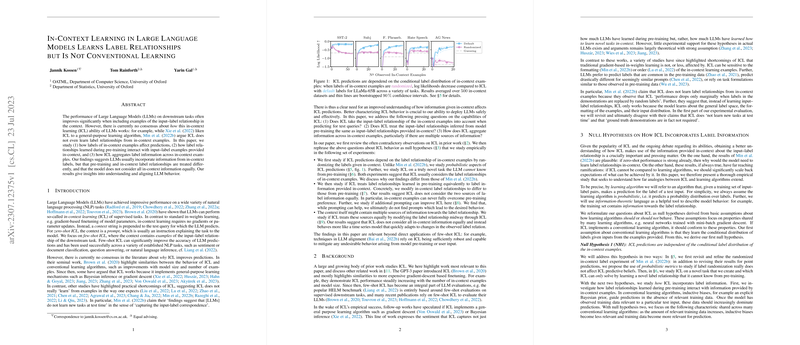The paper "In-Context Learning Learns Label Relationships but Is Not Conventional Learning" explores understanding the inner workings of in-context learning (ICL) in LLMs. Here’s a comprehensive overview:
The authors aim to unpack the mechanisms behind ICL, particularly how LLMs utilize examples provided in the input to make predictions on downstream tasks. Despite the significant improvements seen in these tasks when contextual examples are added, there remains a lack of consensus on precisely how this process functions.
Key Contributions and Findings:
- ICL as a Learning Mechanism:
- The paper examines contrasting viewpoints from previous research, where some have argued that ICL acts similarly to a general-purpose learning algorithm, while others believe it does not truly learn from label relationships.
- Through their research, the authors present novel insights suggesting that while ICL does leverage label information, it operates differently from conventional learning methods.
- Probabilistic Analysis:
- The paper conducts a detailed analysis of the probabilistic nature of ICL predictions. This involves understanding how predictions adapt with the inclusion of more in-context examples.
- It is revealed that ICL predictions heavily rely on the labels included in the context, indicating that these labels significantly guide prediction outcomes.
- Capabilities and Limitations:
- The research shows that ICL can indeed learn and adapt to new tasks using the information from the context. This demonstrates a form of learning that captures novel task structures dynamically.
- However, there are noted limitations where ICL struggles to completely override the inherent prediction biases that originate from pre-training. Essentially, ICL does not uniformly utilize all available in-context information, leading to uneven consideration of contextual elements.
The paper contributes to advancing the understanding of how ICL functions within LLMs. By identifying both the capabilities and inherent constraints of in-context learning, the paper provides a foundation for future work aimed at refining and improving how LLMs can be taught to leverage contextual information more effectively. This is crucial for developing models that can generalize better and adapt more fluidly to new tasks and data structures.
